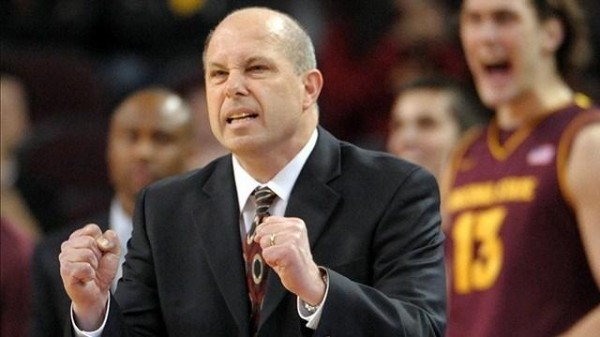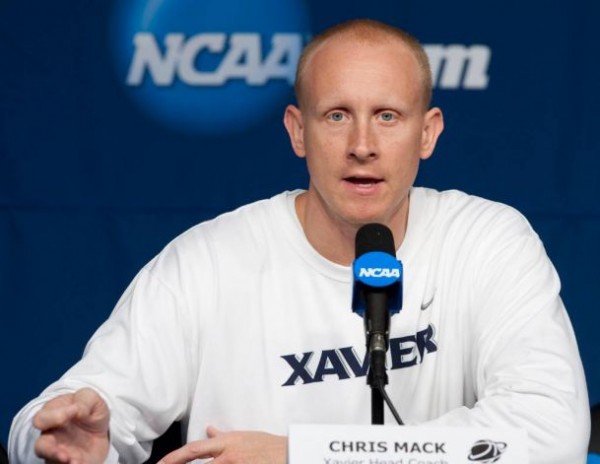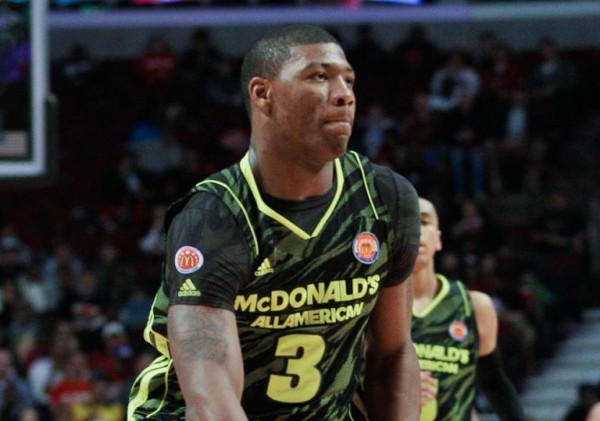Highlighting 11 Freshmen Ready to Play Big Roles on Their New Teams
Posted by Chris Johnson on October 29th, 2012Chris Johnson is an RTC Columnist. He can be reached @ChrisDJohnsonn.
It is not hard to predict the nation’s top freshmen in a given season. Typically, general recruiting rankings do a pretty decent job aiming at a consensus. They pinpoint the players offering the greatest upside and promise at the college level, with an eye toward NBA potential. And most of the time, they are right. We watched this phenomenon unfold last season in the grandest fashion, when the Kentucky Wildcats took in another batch of top recruits, coalesced into a cohesive unit, captivated the college hoops landscape with an unprecedented brand of togetherness and selflessness, and shattered old axioms about the importance of experience and veteran leadership in the NCAA Tournament, all en route to a national championship. To be clear: 2011-12 Kentucky’s freshmen were not what we call elite; they were special, precocious in so many ways, far ahead of expected developmental paths. Not every top 10 recruit is an Anthony Davis or Michael Kidd Gilchrist or Marquis Teague. Most of the time, the blue chippers – the recruiting crème de la crème, the five-stars, or whatever moniker works for you – are extremely capable players with high developmental curves, packaged with a specific trait (athleticism, floor vision, shot-blocking, you name it) that separates them from the rest of the pack. If you can land one of these players, your team, needless to say, is extremely fortunate. Sealing one of these guys means instant credibility and, if all goes according to plan, success.

So much of the Sun Devils’ season depends on Jahii Carson’s ability to produce right away (Photo credit: US Presswire).
There are times when these recruiting gems don’t pan out at the next level, when lower-ranked players outplay their more-touted classmates. This can happen for a number of reasons. Often times, it has to do with opportunity, the sheer need-based requirements certain programs afford to incoming freshmen. When teams lose a significant number of minutes of starters from the previous season, freshmen – whatever their star ranking – are often asked to step in and fill the void. These players are in better position to have big debut seasons than higher-ranked freshmen who get buried on the depth charts (or redshirt) of deep and experienced rosters. It’s why some prospects spurn established programs with winning track records to chase more playing time at a less-prominent hoops locale. They step on campus expecting to play right away. Coaches have long since used this carrot as a recruiting trick. My job is to pin down these players. By surveying each team’s positional needs, and the recruiting work they did to fill those needs, I’ve come up with a group of newcomers who figure to play important roles on their respective teams. Selections may coincide with the top-end of 2012’s recruiting rankings, but inclusion is based more on circumstance than bare talent and scouting merits.
Jahii Carson – Arizona State. Unless Arizona State shows significant improvement in 2012-13, just one year after posting a 10-21 record and 10th place finish in an abysmal Pac-12, coach Herb Sendek’s seventh season at the school could be his last. Preventing that fateful outcome will hinge largely on Carson’s ability to navigate the backcourt and facilitate the Sun Devils’ offense, whose 98.4 adjusted offensive efficiency rating ranked near the bottom of Pac-12 teams, according to kenpom.com. Carson, who was ruled an academic non-qualifier last season, will be handed the reins on offense. He spurned offers from the likes of UCLA, Arizona, Washington and Memphis to stay in his home state. Now Carson has the chance to prove he made the right decision.
Sam Dekker – Wisconsin. With Mike Bruesewitz’s horrifying injury (read at your own risk), and the departure of floor-general Jordan Taylor, Dekker – the rare five-star talent to embrace Bo Ryan’s slow-down system – will enter the fold with big expectations and aspirations. The Badgers will likely challenge for a top-four Big Ten finish, because the Badgers always finish in the top four. (In 11 seasons under Ryan, the Badgers have never finished lower than that position). For that to happen again this season, Dekker will need to help fill Taylor’s monster role. To be fair, they’re completely different players – Taylor was a point guard; Dekker a 6’ 7’’ forward – but the freshman needs to help initiate and ignite the offense in a way only Taylor could last season. The Badgers tend to get stagnant on that end of the floor, to settle for too many three-point shots. Dekker promises to add versatility and to bolster Wisconsin’s workmanlike ethos on both ends.
Kyle Anderson – UCLA. The reason Shabazz Muhammad isn’t in this spot is simple: the Bruins need Anderson’s play-making more than Muhammad’s scoring. Muhammad is probably the best player in the 2012 class, and his arrival (or non-arrival, depending on how quickly the NCAA deals with his eligibility issues) will be huge. It’s just that Anderson’s claim to the point guard spot feels more important. We saw how Larry Drew II restricted UNC’s offense two seasons ago, and how it exploded once Kendall Marshall took over. Anderson’s unique playmaking ability and scoring touch, all packaged tidily within a 6’ 7’’, 210-pound frame, make him arguably the best skills-to-size players in the 2012 class. Like Marshall, Anderson can ignite the Bruins’ offense in a way Drew can’t. Provided he clears his own eligibility hurdles, Anderson will thrive.
Ronnie Johnson – Purdue. This offseason, Purdue lost one of the best players in program history. Robbie Hummel’s departure, after six long years on the campus, felt like the end of an era. The future belongs to the Boilermakers’ 2012 recruiting class, which features three top 100 players, according to ESPN.com’s recruiting nation. Johnson will have the best opportunity to play right away. That’s because senior point guard Lewis Jackson followed Hummel out of West Lafayette last season. Purdue is undergoing a transition of sorts, and Johnson will be in the spotlight throughout that process. If Johnson acquits himself to coach Matt Painter’s hard-nosed philosophy, and junior guard Terone Johnson continues continues his upward progression, an NCAA Tournament bid feels within reach.
D’Vauntes Smith-Rivera – Georgetown. Losing Jason Clark and Hollis Thompson will hurt the Hoyas’ perimeter scoring prospects. Smith-Rivera, whom scouts laud for his versatility and ability to beat defenders off the dribble, is a practical solution. The Hoyas oversaw the star turn of one Otto Porter, a less-touted freshman who blossomed in his first season with the Hoyas. Georgetown doesn’t need Smith-Rivera to contribute Porter-like offensive production. They need him to play to his strengths, which – far as I can tell – make a perfect match for John Thompson, III’s Princeton offense. That is good news for the Hoyas.

After losing Lyons and Wells, the Musketeers need Christian to score from the backcourt (photo credit: AP Photo).
Semaj Christian – Xavier. Last season brought drastic changes to Xavier’s frontcourt. It all started when point guard Mark Lyons, whose attitude concerns didn’t mesh well with the type of cooperative locker room environment coach Chris Mack is trying to build, transferred to Arizona to reunite with former Xavier coach Sean Miller. Then starting guard Dez Wells was abruptly suspended and expelled on a mysterious sexual allegation that was later challenged and revoked in court. The series of events was a troubling reality for Xavier fans — a backcourt that once looked like a strong point, an area to build around, is severely depleted. Enter Christian, who by virtue of last year’s unexpected defections, will be asked to shoulder a sizable scoring load.
Gary Harris – Michigan State. If there’s anything we’ve learned about the Big Ten over the past decade, it’s that overlooking Michigan State is, with little exception, a mistake. Tom Izzo has established a winning culture and the level of consistency needed to overcome critical departures. Replacing Draymond Green won’t be easy, but Harris is the kind of player who can help replace Day-Day’s versatility. He and point guard Keith Appling will man one of the Big Ten’s best. That alone should keep the Spartans in the hunt. If Harris arrives as advertised – the No. 2-ranked player at his position and the No. 11 player overall – Michigan State could be even better than it was last season (and the Spartans were a #1 seed, if you’re forgetting).
Devonta Pollard – Alabama. There’s something numbing, something boring, something blasé about teams built on defense and low-tempo attacks. They never get the same hype as their up-tempo brethren. It makes sense, even if it’s wrong. Because there are a score of very good teams – Alabama being one of them – that have refined boringness and vanilla schematic principles into extremely effective game plans. This season, Alabama will use its hard-nosed mentality to challenge Kentucky, Missouri and Florida atop the SEC. Pollard will be a huge part of that equation, thanks largely to the losses of wing Tony Mitchell and forward JaMychal Green. Pollard looks poised to shine upon arrival, though you may not hear about it until March, because these Tide don’t win games with highlight-reel dunks or scoreboard-turning dramatics. They lock you down and guard the heck out of you; Pollard will advance that effort seamlessly.
Winston Shepard – San Diego State. There are plenty of reasons to be excited about UNLV this season. They bring in one of the nation’s top recruiting classes to enter a lineup with a boatload of returning talent. But before you hand the MW crown over to the Rebels, don’t count out San Diego State. Everyone knows about league player of the year candidate Jamaal Franklin, about three-point specialist Chase Tapley, about the Aztecs’ building momentum. Now add Shepard, whose athleticism and size (6’ 8’’, 250 pounds) make him a perfect fit for Fisher’s interior rotation. The Aztecs will be explosive on the offensive end. What Shepard promises to bring is smothering perimeter defense, the type of relentless ball pressure that could tip the balance against the vaunted Rebels.
Marcus Smart, Oklahoma State. There was no limit to the hype and praise heaped upon Le’Bryan Nash. Oklahoma State had every right to believe Nash could lead them to a high-end Big 12 finish and an NCAA Tournament bid. Nash was good last season, but he hardly lived up to the massive expectations. Now Smart finds himself in a similar spot, only his debut feels more significant, particularly as it pertains to coach Travis Ford. It’s no secret that Ford’s time is wearing thin in Stillwater, so thin that a failure to break the Tourney threshold could leave him out of a job by season’s end. Smart has the natural talent and positively-contagious work ethic to lead the Cowboys to shore up Ford’s future at the school. Or he may struggle to make the transition, and have a season like the highly-touted juggernaut that came before him. Scouts rave about Smart’s toughness and intensity and believe he’s better prepared to make an immediate impact in his freshman season. For Ford’s sake, I hope they’re right.
Glenn Robinson III – Michigan. For the first time 1985-86, Michigan finished the regular season with a Big Ten championship. Coach John Beilein, per the usual, uitilized a perimeter-oriented lineup — stuffed to the gills with experienced shooters like Matt Vogrich, Stu Douglass and Zack Novak – to mask a relatively weak frontcourt. That is no longer the case; these Wolverines have more than enough heft up front to challenge the Big Ten heavyweights. In most cases, that counts as a positive. In this case, I’m not so sure. Beilein’s guard-focused attack will require significant philosophical and personnel adjustments. Robinson III will help that transition with an imposing blend of athleticism and scoring prowess and toughness matched by a only a select few recruits in this class. The perimeter scoring he provides could be the mid-range link Beilein needs to sort out this unusually big lineup. All-conference recognition is a realistic goal for little “Big Dog” or “Big Puppy” or whatever you want to call the talented forward.













































